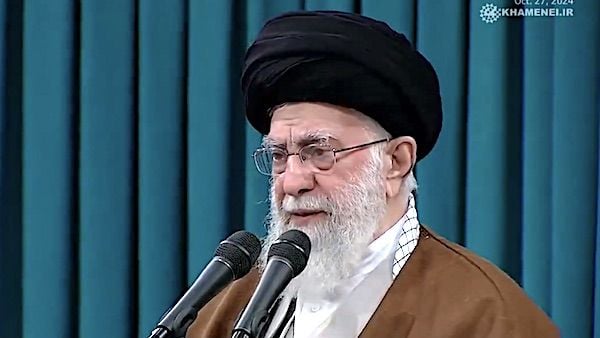By Bob Unruh
Copyright wnd

Have we arrived at a turning point in America, where our foreign and domestic threats have converged?
It appears that Tehran has spun an intricate strategy to threaten the homeland, Americans as well as values that shape the fabric of our culture.
In 1979 when Ayatollah Khomeini was leading the Islamic revolution in Iran, he vowed to export his revolution abroad. He famously declared the United States and Israel satans and dreamt to conquer Qods (Jerusalem). When Iraq attacked Iran, Khomeini insisted that “The road to Qods passes through Karbala (present day Iraq)” and persisted to stay in the devastating war.
His thirst for vengeance remained unquenchable, to bring so-called American imperialism to its knees. “Even if they build mosques all over America, don’t forget the mantra of ‘death to America,’” he warned as he masterfully commingled propaganda with policy.
Over the past four decades, the Islamic Republic has proven that these fiery words were not spoken in vain, and that there is a strategy behind the slogans. The regime established a network of proxies across the Middle East, established the Quds forces to monitor and target Jews and Israelis around the world, erected hundreds of mosques and Shia institutions globally to promote their ideologies, and fomented a global narrative that holds America responsible for much of the suffering around the world. “Death to America” remains as the most repeated chant in Iran.
Many Americans are uninformed or in denial about such a phenomenon, perceiving the Iranian influence as something limited to the Middle East. But the Islamic Republic’s presence has made its way in the US and is posing an escalated threat, especially after the 2020 killing of Qasem Soleimani. One should remember the Supreme Leader Ali Khamenei’s call to avenge Soleimani’s blood.
The call has been repeated by the regime’s spokespersons around the world. Recently, English-language-Ijtihad Network published the words of senior Iranian Grand Ayatollah Makarem Shirazi as a fatwa on their website: “Any person or regime that threatens the Leader or Shīʻa Marjaʻ is considered as Muḥārib Allāh… It is necessary for all Muslims around the world to make these enemies regret their words and mistakes… a Muslim who abides by his Muslim duty…will be rewarded a fighter in the way of God, God willing.” Like the fatwa against Salman Rushdie, the call for blood of a “Mohareb” lingers as an open call until one day a lone wolf makes it actionable.
It appears that for the Iranian regime’s foot soldiers the “enemies of God” are not only high level politicians like President Trump, Ambassador John Bolton, and former Secretary of State Mike Pompeo who have been facing ongoing threats. The regime is working to control the narrative in the media to favor their agenda by threatening journalists and citizens. The kidnapping and murder plots against Iranian-American journalist Masih Alinejad thankfully were foiled by the FBI and the culprits are awaiting trial in New York City. But France-based journalist Rouhollah Zam and US green card holder Jamshid Sharmahd were kidnapped, tried, tortured and executed in Iran in an attempt to intimidate and silence activists and journalists. Indeed, the problem is much more widespread than most people realize. According to Reporters Without Borders, at least 200 activists and journalists in the US and Europe have reported harassment and threats by elements of the Islamic Republic.
The Regime’s expanding frontier of transnational repression affects more than American journalists and politicians; they are increasingly eroding pillars of American democracy. On one hand they silence reporters, on another hand they abuse the first amendment to spread disinformation on social media platforms, promoting their propaganda and political agenda. There are countless reports of Iranian trolls attacking public figures and silencing online dialogue.
They also have sought to weaken the American electoral process, the hallmark of American democracy, by compromising political candidates in the digital space. Various reports of compromised candidates’ accounts have created confusion and eroded the confidence of the American voters, regardless of whether Iran’s favorite candidate obtained a victory.
On college campuses, the Islamic Republic wields its influence in lectures and libraries, injecting future generations of Americans with ideas that promote Iranian soft power. Until just recently Iranian professors with dubious pasts like Mohammad Jafar Mahallati at Oberlin or Seyed Hossein Mousavian at Princeton remained secure in their positions. Robert Mally, the former US Special Envoy to Iran in the Biden Administration who remains under investigation for mishandling classified material, currently holds a teaching position at Yale where he reportedly invited former Iranian Foreign Minister Javad Zarif as a guest speaker. The former minister of a regime that calls for death to America is given a platform at an elite university by a former US diplomat who is under investigation. Let that sink in.
Iran’s influence on college campuses also appears in more subtle ways. Since October 7, it’s been impossible to miss the student protests on US campuses as young people defending the actions of Hamas or the sinking of civilian ships by Houthi rebels in Yemen. Many might not realize it, but the students celebrating such violative behaviors frequently use materials from Iran-supported sources. Although the ayatollahs in Iran don’t take credit for the students’ violence and protests, they praise them from their platforms.
The presence of such anti-American attitudes and behavior among college-educated is alarming. These future leaders will shape domestic and international policies that will be founded on the principles of American culpability — the fundamental tenet of the Islamic revolution in Iran. Regardless of Iran’s direct interference, their influence is already shaping the future minds.
In 2022, hundreds of children in Houston Texas as a Shia mosque chanted “Hello Commander,” an ode to Iran’s Supreme Leader Khamenei in a gender-segregated procession of girls in hijabs and boys with names of Shia Imams on their headbands. This was not a religious event, it was a political exercise, hailing Khamenei as a leader on American soil. It was largely ignored by the American media.
Perhaps the most striking example of symbolic infiltration came in summer of 2022, when Arbaeen commemorations at the White House featured flags honoring the Shia Imam Hussein. Images went viral across Iranian media, hailed the demonstration as a “triumph” and evidence that the regime’s “dream of turning the White House into a Husseinieh”—a Shia shrine—was one step closer. Once again, American media outlets largely ignored it. Whether the lack of coverage was an oversight or the media’s ignorance of what the scene represented, the ambition of the Islamic Republic could not be more clear.
From assassinations and kidnapping plots to disinformation campaigns, campus influence, and symbolic victories, Iran’s strategy reveals a single truth: America can no longer afford to undermine the multilayered threat of Iran’s revolutionary war on America.
Marjan Keypour is an Iran analyst and an activist for the rights of women and minorities in Iran. She is the founder of StopFemicideIran.



